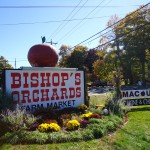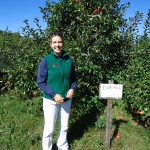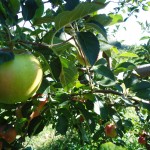“It is remarkable how closely the history of the apple tree is connected with that of man.”—Henry David Thoreau

In line at Bishop’s Orchards, sticky-fingered kids tugged at their parents’ pants, demanding more caramel apples. Outside, more children roamed, trying to pick up pumpkins too heavy for them to lift. It was a sunny afternoon, the first Saturday in October, and crowds had gathered to celebrate the apple harvest at the farm and market in Guilford, Connecticut. Two little girls sang to the tune of Frère Jacques, as their father pushed them in a wheelbarrow: “We are pumpkins, we are pumpkins, eat us quick! Eat us quick!” Other families stood at long tables, stuffing old clothes with straw and decorating them with bits of yarn to make scarecrows. An older woman walked by, singing softly: “You are the apple of my eye.”
Arriving at Bishop’s that October afternoon, I felt at home. A Connecticut native, I spent my childhood among the trees of Applegate of Avon, an orchard owned and operated by my onetime babysitter, Nancy Hanelius, and her husband, Ray in Avon, Connecticut. I can still remember the dark, cool, cavernous room where apples were stored. The Hanelius family has since sold their farm, and uniform, colonial-style houses now stand where apples once grew. Their story is not unusual. Since 2000, Connecticut’s annual apple production has dropped by 2 million pounds. Bishop’s Orchards, however, has managed to continue operating.

“It’s a neat place,” said Jim Plunkett, a Guilford native who attended the town’s high school with Bishop’s current CEO, Keith Bishop. “They have been around forever. They are a Guilford fixture.”
The Bishops have owned and operated Bishop’s Orchards for six generations, since 1871. They steered the farm through the Great Depression and the construction of Interstate 95 in the 1950s through a swath of what had been Bishop land. The small children making scarecrows that day owed their fun to a long tradition that now rests on the shoulders of Keith’s four children, the youngest members of the Bishop family: Ryan, Carrie, Allison, and Sarah, his oldest.
Sixth Generation

Sarah Bishop-Dellaventura loves apples. For her October wedding—“I had to get married during prime-time foliage”—her centerpieces were apples. Her party favors were two hundred jars of applesauce, homemade by her grandmother. Her place settings were colored leaves, and her decorations included mums and pumpkins. She would have held the ceremony in the apple orchard, if it weren’t for the potential problems a Porta-potty poses to a wedding gown.
When I asked Sarah her favorite type of apple, she didn’t think twice. “My favorite, and probably everybody else’s,” she said, “is Macoun.” We were standing just inside the entrance of the grocery store at Bishop’s Orchards, which stocks grass-fed beef, gluten-free cookies, local vegetables, and organic frozen foods alongside the bakery breads, fudge, pies, fruit wines, apple cider, and, of course, the fruit. Sarah explained that the produce section is here, at the front, because this store started as a farmer’s market and produce remains at its heart.

At the forefront of the produce section are the apples. All grown at Bishops’ Orchards, they come in rows, in big white sacks, and in every variety. Copies of a green Xeroxed sheet, titled “Know your apples,” sit at the ready, categorizing the qualities of 16 varieties of apple and the fitness of each to eating, salad, pie, sauce, baking, and canning. On the reverse are nutritional facts about apples, paragraphs titled “Apples Relieve Tension” and “Nature’s Toothbrush,” and a recipe for applesauce.
Here, at the front of the apple section, are the Macouns. “You bite into it and get that snap right away,” said Sarah. “A great eating apple.” They sell out quickly. “As soon as we start saying we have Macouns,” she continued, “people come out of the woodwork to get them.” With a sharp eye for these trends and a degree in business from Northeastern University, Sarah is poised to handle the booming business behind these apples.
She is the oldest of the four siblings. The others are Allison, a teacher; Carrie, an accountant; and Ryan, still a student. When it became apparent that neither of her sisters who had come of age was eager to take on the farm’s operation, Sarah left the career she’d begun in marketing for Bishop’s. “I think everyone says, ‘What if,’” she says now. “No matter what industry you’re in. I may be wrong, but I think everyone has that side of them that says, Hey, I wish I could have been something else…There’s just not enough time in a short life.”
Without training in spraying, pest management, or any of the other day-to-day tasks of a farm’s operation, it’s possible that Sarah may not be able to run the farm alone, as her great-uncle later told me. Watching Sarah handle the day’s tasks, however, I never would have guessed. Periodically, her cell phone beeped—always a crisis. “You’ve got to be kidding me,” she said, as we stood in front of the cider. “I’m having a heart attack as we speak.” She picked up a few bottles, examined them, replaced them, and hung up the phone. “Always something.” This time, she had been informed that the bar code on the redesigned cider label was incorrect. The last time, the grill near the apple trees, which had been turning out hot dogs for customers picking apples, was out of propane. To solve that problem, she found her father, Keith Bishop. Keith is one of the current CEOs of Bishop’s Orchards, in charge of its business operation. His cousin Jonathan, who presides over planting, harvesting, and spraying crops, is the other.
There are blood Bishops, Sarah explained, as we sat on straw bales, readying ourselves for a hayride around the apple orchard, and then there are spouses, like Sarah’s mother and uncle. Besides Sarah, her father, and his cousin, blood Bishops currently involved in the farm’s operation include her aunt, the bakery manager. It is Sarah’s grandfather Albert Bishop and her great-uncle Gene Bishop, however, who remain the Bishops’ reigning patriarchs.
Fourth Generation
“This is the kind of weather we dream about,” crowed Gene when I joined him in his office one October day. “These are the days that make or break the business. A good weekend like this goes a long way.” From the lines of customers and cars parked close on the grass, I could see what he meant. I could see how the farm’s success might hinge on a single perfect day.
Gene had just come from home, but, like all the other Bishops and Bishop employees, he wore a forest-green polo shirt with the company’s logo over his heart. He lives next to Bishop’s Orchards, and always has. “I can walk up that hill up the street over there,” he said, “and I can see all three houses I’ve ever lived in.” Gene drove a tractor for the first time in 1938, when he was five years old, eight years after a Connecticut agricultural report noted the Bishops’ own New Haven County as the largest apple producer in the state.
Growing up during the Great Depression, Gene graduated from Guilford High School with a class of only 32. “It was a small class,” he quipped, “because anyone born in 1933 was not planned.” After a few years at the University of Connecticut, Gene returned to Bishop’s Orchards, married his wife at 21, and went about beginning his life as a farmer, working with his father and his uncle. He sold life insurance on the side for the first few years, but after that, he restricted his activities to farming and farm management. He enlisted during the Korean War, and then delayed his service in order to farm.
“It’s been a very rewarding life,” Gene said. “The longer I’ve been here, the more I like it.”
He has been here long enough to remember peddling “second”-quality apples door-to-door around town. He can remember 1957, when Bishop’s Orchards was incorporated as a business, with Gene’s father as president, Gene as vice president, Gene’s cousin Albert as secretary, and Albert’s father as treasurer. Gene continued to work for the farm until his son Jonathan and Albert’s son Keith took over. After that, Gene ran the town. He served ten years on Guilford’s Board of Selectmen, two of them as First Selectman, and he currently serves as the Chairman of Guilford’s Public Works Commission.
When Gene showed me the map hanging on the Bishop’s Orchards’ office’s wall, I could see that here in Guilford, his leap from farm management to town management was logical. Bishop’s Orchards occupies a large patch of town. In fact, when this map was made in 1970, even more of Guilford was covered in farmland. Gene stood and pointed out places where three other orchards once stood, all within a stone’s throw of Bishop’s.
Sullivan’s Orchards is all grown over, he said, because after Don Sullivan retired twenty years ago, none of his family would resume its operation, and “the farm just sat there.” Hilltop Orchards, too, “stopped growing anything” a long time ago. Desperate for funds after he couldn’t find anyone to inherit its operation, Hilltop’s last owner-operator sold all the topsoil. “He doesn’t have anything left to grow on,” said Gene. “He sold the land to the YMCA.” Until recently, Guilford’s only active farm and farmer’s market besides Bishop’s was Fanicello’s, but its youngest generation showed no interest in their inheritance, and now, the land lies fallow.
“We’ve been fortunate so far,” Gene said of his family, whose way of life depends on the willingness of the sixth generation of Bishops to continue the farm’s operation.
An Inheritance for Generations
The Bishops usually employ about one hundred non-Bishops, Sarah explained, as we clambered aboard the hayride. This time of year there are closer to 120, or 140. Non-Bishop employees include a man whom Sarah called “Crazy John,” the man driving our hayride. Kids wait for his tractor, she explained, because they know he gives the fastest ride. “Most kids do end up crying,” joked Crazy John, as he latched the hayride’s railing behind us, “so I know I’m doing a good job.” Sarah and I sat on the straw as Crazy John went into the tractor and started up the hayride.
When we reached the top of the hill, the ride stopped with a shudder, and more passengers boarded. An hour later, people would line up twenty deep to take the ride to the best apple trees in this 220-acre section of land—the largest continuous piece of the 313-acre farm, where rows of apple-freckled trees are clearly labeled so the orchard’s patrons can know whether they’re harvesting Ida Red or Macintosh, Golden Delicious or Stayman. After all, some pickers are quite picky.
“Get the reddest, most beautiful,” said one mother to her three small girls. “And this is how you do it. Listen to me before you pick an apple. Twist, twist—and then pull.” The family lives in Guilford and comes here, the mother told me, “just about every year.” Her daughters toddled at her feet, holding buckets, and their father explained today’s strategy. “My wife wants to make applesauce and pies,” he said, “and I want some for eating. We tried to pick the ones that were good for all of those categories. Jonagold, Mutsu, and—what was the other kind we were looking for?”
“Cortland,” supplied his wife.
“Oh,” he said, “I see some over there, girls!” And the girls ran off, buckets in hand, between the rows, the early afternoon sun shining off their white-blond heads. It was that time of year.
“Something about apple-picking and fall foliage—it screams New England,” Sarah said. “I can’t imagine living anywhere else this time of year.” In fact, the American tradition of apples is rooted in New England, where early English settlers first introduced the fruit. By 1641, representatives of the king of England had decreed that settlers claiming more than 100 acres of land in the colonies must use some of that acreage to plant apple trees. Apple seeds and seedlings later found their way from New England into wagons of settlers headed westward. Johnny “Appleseed” Chapman, the legendary outdoorsman who took sacks of apple seeds down the Mississippi and deep into the frontier, was from Massachusetts.
Today, Yale students frequently visit nearby Bishop’s Orchards on field trips subsidized by their residential college masters, who want to give all their students the chance to acquaint themselves with the autumn harvest. “The fall trip to Bishop’s Orchards for apple picking is a decade-long Pierson tradition,” proclaimed the “Pierson Sun,” a newsletter of Pierson College, in October. For these new Connecticut residents, it’s an important introduction to their home.
Unlike the Hanelius family, who owned the Connecticut apple orchard of my childhood, the Bishops feel no economic pressure to sell their land, Sarah reassured me. The only pressure comes from loyal customers who want to make sure the Bishops keep the land they have farmed for 139 years. To Guilford residents, what Sarah is poised to inherit is nothing short of a legend. She told me that growing up a Bishop was hard, because everyone in town recognized her and her siblings—and knew their parents, whom they’d notify when Sarah so much as ran a red light. “I grew up living in a glass house,” she said. “Everywhere you went,” her sister Allison Pasquier added in an e-mail, “people would ask if you were a Bishop like the apple Bishops.” In Guilford, the Bishops are an institution—one whose maintenance requires work, perseverance, and a certain steely attitude.
Fifth Generation
Keith Bishop, Sarah’s father, wears many hats. His business card reads, “Co-CEO, Treasurer & Winemaker.” Also the Vice Chairman of the Guilford Board of Education, he told me he doesn’t take lightly his status as community leader. “To me, Bishop’s Orchards is synonymous with my family,” wrote Allison, “especially my father, who has lived his entire life in the context of the farm.” Keith’s e-mail signature includes a quotation from Richard Brinsley Sheridan, a nineteenth-century British politician: “The surest way not to fail is to determine to succeed.”
Keith is a businessman. When I asked him about Bishop’s Orchards, he leapt quickly to “services we’re offering,” “product lines,” and maintaining the building’s “historical look.” The Bishops are active in lobbying for agricultural initiatives, and they are charter members of the University of New Haven Center for Family Business, where they learn to stay on top of trends, Keith said. He began cutting cabbage and lettuce in the farm’s vegetable beds as a boy, and he returned to work immediately after graduating from Cornell. He has been CEO for 12 years, and he spoke fluently of trends in apple picking that vary with the traffic of New Yorkers to their houses on Cape Cod.
Keith is the man to run this farm, but he plans to retire sometime over the next ten years, passing along his title to one of “those in the next generation who are interested in the business.”
“Whoever that is,” he added.
The Last Generation
Jonathan, Keith’s cousin, has no children, but Keith has four, all of whom grew up with Bishop’s Orchards in mind. “The most memorable moments from my childhood would be the Guilford Fair Parade, which was always in September,” wrote Carrie Bishop, the youngest daughter, in an e-mail. “We would stay up almost all night the day before the parade to build a float that represented the farm, and would ride on the float in the parade as my Dad drove the tractor. We are a pretty tight family brought up with good traditions and values.”
Carrie now lives in Boston, working as an auditor at KPMG, an audit, tax, and advisory services firm. Recently engaged, she plans to settle in Massachusetts. “Currently, I do not have any hobbies that bring me closer to the farm,” she wrote, “besides being very picky about the fruit and produce I buy.”
Allison, the middle daughter, is living with her husband in Brussels, teaching preschool at an international school there. She wrote from Belgium that she loves shopping at the farm market when she’s home, but can’t see leaving what she does to take a more active role in its success. “As for her future,” said her father, “she’s doing her thing.”
That leaves Sarah—and the youngest sibling, Ryan Bishop, who was out hiking with a Bishop cousin at twelve years old when he first realized that he and the other boy were the last two Bishops capable of passing on the family name. “Some people think my dad kept having kids until he had a son,” he’ll say now, recollecting that hike from his dorm room at Cornell University, his father’s alma mater, where he’s studying agricultural sciences and plant sciences with double minors in modern business and viticulture.
“At this point, I’m pretty sure I’m going back,” said Ryan, after listing his majors and minors. He would fill Jonathan’s shoes as farm manager while his sister, like his father, keeps the books. Like Sarah, he’d like to enact certain changes to the farm; like Sarah, Ryan anticipates resistance from the conservative older generations, who continue to hold stock in the business after they retire. He’d especially like to put in grapevines.
“In middle school, people associated me with apples and gave me relevant nicknames,” Ryan said. Even so, Ryan’s future as a farmer was never a foregone conclusion. He entered Cornell as a pre-med student, shifting majors around the same time Sarah left her career in marketing. Ryan’s hobbies include playing saxophone and guitar, rock climbing, ice climbing, and whitewater kayaking. However, though he’ll join friends on a rock-climbing trip to Nevada over spring break, pruning work at Bishop’s Orchards was his destination in December.
Yet before he returns permanently, Ryan has two years left at college. In compliance with a Bishop family rule that young Bishops of his generation must work for two years outside the orchard before returning to the family business, he’ll then take more time away—at another farm, he offered, in order to learn new techniques, or perhaps pursuing travel coordinated through WWOOF, World Wide Opportunities on Organic Farms. He also plans to apply to the Peace Corps. Those mandatory two years away from the farm, he said, might turn into five or ten.
His uncle, Keith’s brother, abandoned Bishop’s Orchards to start his own farm in Pennsylvania. Ryan plans to return to the farm, but how long he’ll take “would depend on where I land when I get out of college, how much I enjoy what I’m doing,” Ryan explained, all too aware of the sacrifices he would make. “My free time would be cut down significantly if I were running the farm myself. Once Jonathan takes off, it’s on my back.” About the possibility of return to the farm, Ryan speaks dutifully and carefully, the sharp focus of this picture of the rest of his life giving an edge to his voice as well.
For Now
When Sarah and I disembarked the hayride, she found a comfortable picnic table, got us some cider, and we sat and talked business. Sarah told me to watch out for the bees that our opened bottles of cider attracted. She seemed to have inherited her father’s savoir-faire, mentioning renovation projects and trends that affect the grocery store (acai berries, gluten-free, the movie Food Inc). It’s a large-scale operation: this time of year, the Bishops receive deliveries of twenty to thirty tons of pumpkins weekly. Bishop’s Orchards closes only seven days out of the year.
And yet Sarah seems up for anything. Her father emphasized to me that Sarah keeps too busy with her young children and the farm, but in person, she doesn’t show it. Tucking her blonde hair behind her ear, smiling when she talks, she is bright, efficient, and bubbly. The hayride was her idea.
Growing up, Sarah never thought she’d take over the family business. For a long time, in fact, she thought she might be a teacher. Then, after graduating from Northeastern, she worked for three years as marketing manager at Moffly Media in Greenwich, Connecticut. This job happened to comply with the Bishop family rule—but, that mandate notwithstanding, Sarah had her own goals. She had planned on living in New York and “working for some big magazine or ad industry.”
“I envy her,” Sarah said of her sister Allison, the one who lives in Brussels. “I think in my next life, maybe I’ll do what she does.” But for now, Sarah has prioritized Bishop’s Orchards. “I decided as the years went on that I wanted to see the business continue,” she said. In her sisters’ absence, Sarah has decided to take on the farm, with all its limitations. “As frustrating as it can be to work with family,” she says, “you do it.” You do it if you love the farm as much as Sarah does.
“This is what I grew up doing,” she continued, batting a bee away from her hair. “It’s what I love. I’m hap—pretty happy. I’m pretty happy…I feel stressed about it at times, but I never have any remorse.” She persists in the hope that her brother will grow up to join her—in whatever hope has kept this business afloat through 139 years of modernization. The strongest guarantor of Bishop’s Orchards’ survival is to keep it in the family. “I can’t picture this all being houses up here,” Sarah said, imagining what might happen eventually if the farm were sold to an outside party. “I don’t know if I’d forgive myself.” Apples themselves are cultivated by the grafting of branches onto trees already growing, but this farm’s roots run deep.
Not Far From the Tree
After parting ways with the Bishops, I couldn’t resist buying one of the big white bags of apples—specifically, Macouns. I tried my first Macoun on the way home. The apple was small, filling my palm only partially, and bright red. When I took a bite, its skin gave way with a crunch, revealing a white, sweet interior. It was as crisp and hard as Sarah had promised. I ate the whole thing, quickly, and remembered joyfully that my bag of apples, the smallest size available, still held four quarts. The face of the bag told the apples’ story: APPLES & CIDER – BISHOP’S ORCHARDS – CONNECTICUT GROWN.
This story has been passed on through generations and culminates in that sharp, bright taste. In the end, that’s what all the effort is for. It’s the taste of my childhood and, for one Guilford family, something more important—something else entirely.
But that’s comparing oranges and you-know-what.

